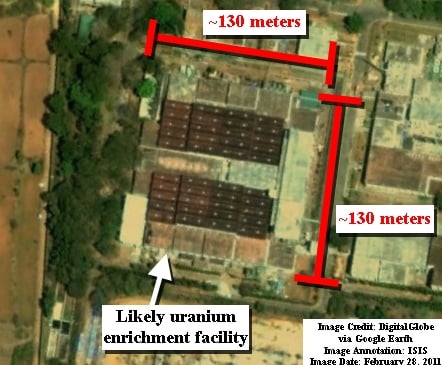
Back when the U.S.-India nuke deal was being sussed out, a lot was made of the impact the deal would have on India’s sparse stock of uranium. Specifically, that the U.S.-India 123 agreement would help India – in “Hill Approps-speak” – plus-up their reserve by enabling them to 1) get LEU from the U.S. to power its civilian nuclear program while at the same time 2) allowing them to use their scarce domestic supply for their military nuclear weapons program. In doing so, the U.S. would therefore be facilitating their military nuke program. This arrangement would also allow them to keep their civilian and military nuke programs partitioned, as required by the deal. Not so cool.
Well, guess what? The imagery analysts over at the Institute for Science and International Security (ISIS) seem to have found something which puts some flesh on that bone of contention. In their latest piece, ISIS once again examines Google Earthy commercial satellite imagery which appears to depict ” the Rare Materials Plant (RMP), the site of India’s military gas centrifuge uranium enrichment facility. The new image from February 28, 2011 shows further progress in the construction of what could be a new gas centrifuge plant.” They compared this latest image with one they looked at from about a year prior (March, 2010), which indicated an earlier stage of the work in which excavation and site clearing for the new facility was taking place. ISIS also finds, based on the satellite imagery, that the new enrichment site will be larger: on the order of 210×150 as opposed to the existing site size of 130×130. ISIS therefore concludes that ” A new gas centrifuge plant would indicate that the military uranium enrichment program is indeed expanding and that further procurement activities are likely ongoing.”
So, to sum up: India is scaling up its enrichment facility with the expectation that it will have sufficient uranium to enrich for its military program. That, in turn, means that whatever LEU it needs for its civilian program will come from outside (i.e. U.S.) sources. Hence, they can use existing uranium stocks to feed into its bigger, better centrifuge facility.
Given what ISIS has concluded from looking at the Google Earth imagery, should the Indian government be sending the USG a “thank you” note? And more importantly, will the USG begin to feel some “buyers remorse” for having gotten the very obvious short end of the stick (as many, many folks concluded when the 123 deal was being put together)?